
Customer-made Press
Laboratory Hydraulic Press Lab Pellet Press Machine for Glove Box
Item Number : PCG
Price varies based on specs and customizations
- Pressure range
- 0-25 T
- Heating temperature
- 0-500 ℃
- studio size
- 780*650*700 mm³
- Transition warehouse size
- φ240*260 mm
Shipping:
Contact us to get shipping details Enjoy On-time Dispatch Guarantee.
Why Choose Us
Easy ordering process, quality products, and dedicated support for your business success.
Applications
A special lab press machine for glove box is a highly specialized piece of equipment used in laboratory settings that allows for the pressing and shaping of materials within a controlled environment. This machine is specifically designed to operate within a glove box, which is a sealed container that allows for the manipulation of materials in an inert atmosphere.
The machine is typically constructed from materials that are inert to the materials being processed, such as stainless steel or polyethylene, and is designed to be easy to clean and maintain. It is operated using a control panel located outside of the glove box, allowing researchers to manipulate the machine without compromising the integrity of the inert atmosphere inside the glove box.
Feature
- Small footprint, light weight, easy to carry and move
- High precision digital pressure gauge
- Pressure can be programmed, hydraulic will restart working when pressure drops to set value
- Can be customized according to your needs
Detail & Parts

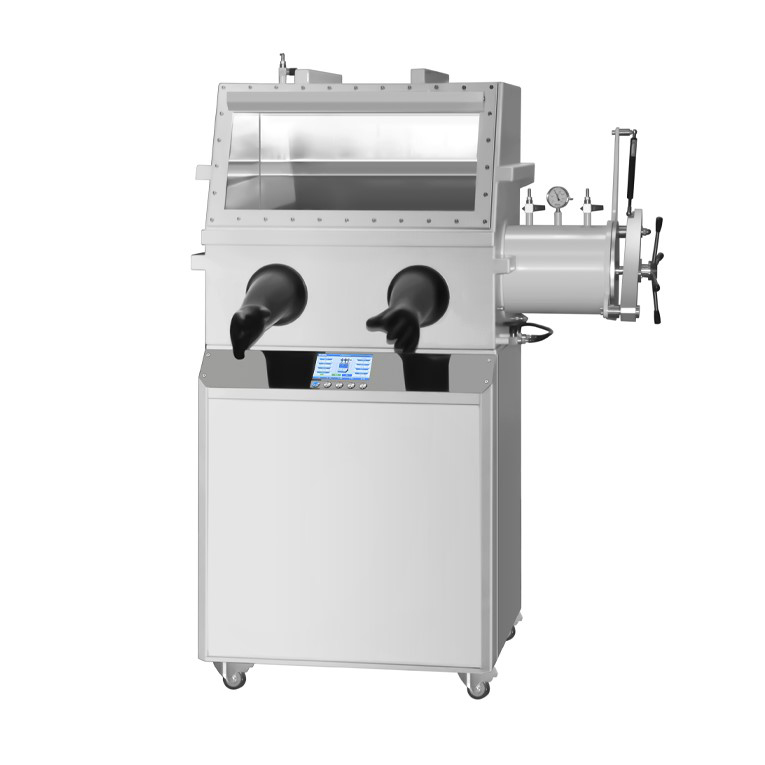
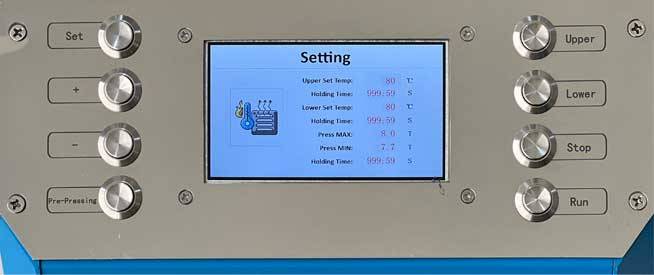
- Set: In the operation interface, press the settings button to enter the settings interface, then press the settings button to move the settings content. After moving to the mold diameter, press the settings button again to return to the operation interface. Note: When the time is set to "0", it means that the time is set to infinity.
- +: In the operation interface, press the "+" key to increase the setting number.
- -: In the operation interface, press the "_" key to reduce the number of settings.
- Pre-Pressing: Press the pre pressing button to close the upper and lower heating plates together.
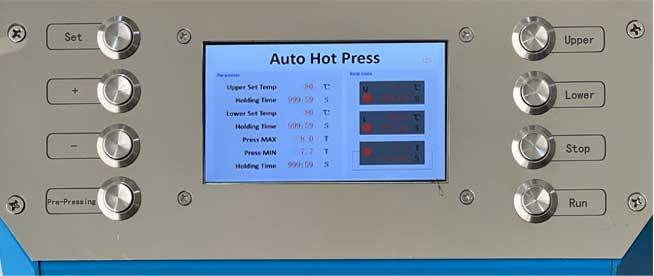
- Upper: Press the "Upper Plate" button on the operation interface, and the upper plate will start heating to the set temperature. After the automatic timing and constant temperature timer are completed, theheating will stop. Or press the "Upper Plate" button again to stop heating the upper plate. During the heating process, all setting buttons are invalid.
- Lower: Press "Lower Board" on the operation interface to stop heating after the timer ends. Or press the "Lower Plate" button again to stop heating the lower plate.
- Stop: When the device is in operation, pressing the "Stop" button will stop the motor from running and open the pressure relief valve to release the pressure.
- Run: Press the "pressurization" button, and the equipment will start. When the pressure reaches the set pressure, stop pressurization and time to maintain pressure. When it is below the lower limit of pressurization, it will automatically replenish pressure. After the timing is completed, it will automatically release pressure.

. Advantages
- The upper plate adopts electroplated countersunk head hexagonal screws, beautiful and space-saving
- Chrome-plated cylinder, smooth surface, no rust, good sealing rubber ring, no oil leakage
- One-piece main board structure, oil pool, main board, oil cylinder in a body, no seal connection
- Extended pulling spring, good rebound effect, not easy to deformation, can achieve the cylinder 30mm return without deformation
- Small size, light weight, no oil leakage
- Mold using Japanese high-speed steel, good material, high hardness, no deformation, long service life
- Digital display pressure gauge, more accurate pressure control, pressure display accuracy of 0.01MPa
- Oil pool outside the host, easy to replace the oil, and the oil circuit increased the hydraulic oil filtration device
- Special plunger, using special custom sealing structure, excellent sealing effect
- Pressurizing device, placed in the lowermost corner of the mainframe, the angle is reasonable, pressurizing force does not tilt back
Technical specifications
| Instrument model | PCG-25T1818 | PCG-25T2020 |
|---|---|---|
| Pressure Range | 0-25T | 0-25T |
| Pressurization process | Program pressurization-program pressure-timed pressure relief | Program pressurization-program pressure-timed pressure relief |
| Pressure retention time | 0-999.59(point.Seconds) | 0-999.59(point.Secinds) |
| Heating temperature | Up to 500℃ | Up to 500℃ |
| Heating plate | 180×180mm | 200×200mm |
| Glove box handle | St's 304 | St's 304 |
| Studio size | 780×650×700 | 780×650×700 |
| Transition cabin size | Φ240×260mm | Φ240×260mm |
| Vacuum degree | -0.1MPa | -0.1MPa |
| Size of the whole machine | 1200×950×1800(L×W×H) | 1200×950×1800(L×W×H) |
| Power supply | 220V 50Hz | 220V 50Hz |

Operation steps

Step 1: Preparing the sample.
The first step in using the lab press machine for glove box is to prepare your sample. You can put the sample into the hot press through the transition chamber or the front sealing flange.

Step 2: Turning on the vacuum pump.
Before beginning the pressurization process, you need to turn on the vacuum pump to pump the air in the glove box to negative pressure.

Step 3: Setting the temperature.
Once the vacuum pump is running, you need to set the temperature of the upper and lower heating plates to the desired temperature for your sample.

Step 4: Setting the pressurization program.
Next, you need to set the pressurization program. This program determines the amount of pressure and time required to pressurize the sample to the desired shape and density. You can set the program using the control panel outside the glove box.

Step 5: Starting pressurization.
After setting the pressurization program, press the start button to start the pressurization process.

Step 6: Keeping the sample at a constant temperature.
Once the pressurization process is complete, you need to keep the sample at a constant temperature for a period of time.

Step 7: Releasing the pressure.
After keeping the sample at a constant temperature for the specified time, you can start to release the pressure.

Step 8: Taking out the sample.
Finally, once the pressure is fully released, you can take out the prepared sample.
Full range of lab press types
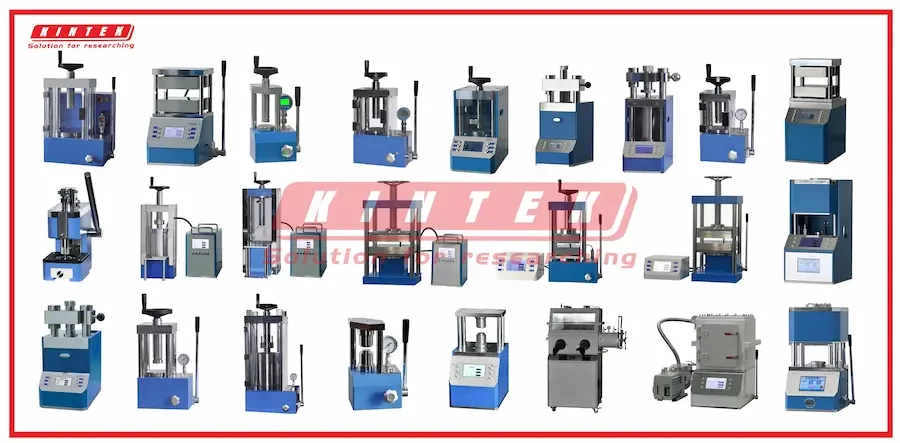
Click to view our full range of lab press products.
Any question? Our experts have helped many laboratories choose their lab press, contact us now!
Full range of types of laboratory press molds
We have a full range of molds for you to choose from, and the molds fit the body perfectly.
If you need molds with special shapes, we can also customize them for you.
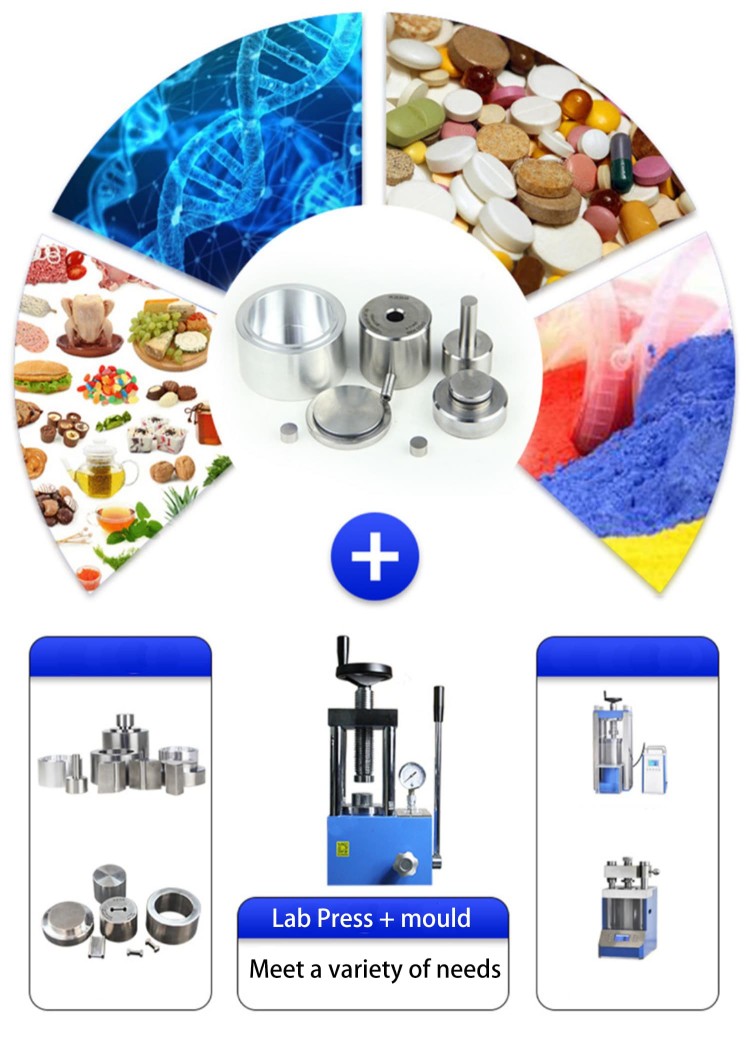
Warnings
Operator safety is the top important issue! Please operate the equipment with cautions. Working with inflammable& explosive or toxic gases is very dangerous, operators must take all necessary precautions before starting the equipment. Working with positive pressure inside the reactors or chambers is dangerous, operator must fellow the safety procedures strictly. Extra caution must also be taken when operating with air-reactive materials, especially under vacuum. A leak can draw air into the apparatus and cause a violent reaction to occur.
Designed for You
KinTek provide deep custom made service and equipment to worldwide customers, our specialized teamwork and rich experienced engineers are capable to undertake the custom tailoring hardware and software equipment requirements, and help our customer to build up the exclusive and personalized equipment and solution!
Would you please drop your ideas to us, our engineers are ready for you now!
FAQ
What Are Laboratory Hydraulic Machines?
What Is A Lab Press?
What Are The Advantages Of Using Laboratory Hydraulic Machines?
What Is The Purpose Of A Hydraulic Press In Lab?
What Are The Applications Of Pellet Presses?
What Are The Advantages Of Using A Hydraulically Heated Laboratory Press?
What Are The Applications Of Laboratory Hydraulic Machines?
What Are Different Type Of Lab Presses?
How Does A Pellet Press Work?
What Does A Hydraulic Lab Heat Press Do?
What Is KBr Used For?
What Are The Main Components Of A Laboratory Hydraulic Machine?
What Are The Benefits Of Using A Pellet Press?
What Types Of Samples Or Materials Can Be Processed In A Hydraulically Heated Laboratory Press?
What Is The KBr Pellet Method?
What Considerations Should Be Taken When Selecting A Laboratory Hydraulic Machine?
What Factors Should Be Considered When Selecting A Pellet Press?
How Does A Hydraulically Heated Laboratory Press Work?
Why KBr Is Used For Pellet?
How Can The Performance Of A Hydraulically Heated Laboratory Press Be Optimized?
How To Make KBr Pellets For FTIR?
5.0 / 5
Fantastic press machine for glove box! Perfect for small laboratories with limited space.
4.8 / 5
The machine arrived promptly and was easy to set up. It's been a valuable addition to our lab, making sample preparation much more efficient.
4.9 / 5
The technical specifications of this machine are impressive. It's a great investment for any lab that needs a reliable and precise pellet press.
4.7 / 5
I've been using this machine for a few months now and I'm very happy with it. It's easy to use and produces high-quality pellets.
5.0 / 5
The safety features on this machine are top-notch. The polycarbonate safety guards and pressure release valve give me peace of mind when I'm using it.
4.8 / 5
The customer service from KINTEK is excellent. They were very helpful in answering my questions and providing technical support.
4.9 / 5
I highly recommend this machine to any lab that needs a reliable and efficient way to prepare samples for analysis.
4.7 / 5
The machine is well-built and durable. I've had it for over a year now and it's still going strong.
5.0 / 5
The technological advancements in this machine are impressive. It's a great example of how technology can be used to improve laboratory efficiency.
4.8 / 5
The machine is very easy to use. Even our new lab technicians were able to learn how to operate it quickly.
4.9 / 5
I'm very happy with the value for money I got with this machine. It's a great investment for any laboratory.
4.7 / 5
The machine is very durable and has held up well to heavy use in our lab.
5.0 / 5
The machine is very technologically advanced. It has a lot of features that make it easy to use and efficient.
4.8 / 5
The machine is very easy to use. Even our new lab technicians were able to learn how to operate it quickly.
4.9 / 5
I'm very happy with the value for money I got with this machine. It's a great investment for any laboratory.
4.7 / 5
The machine is very durable and has held up well to heavy use in our lab.
REQUEST A QUOTE
Our professional team will reply to you within one business day. Please feel free to contact us!
Related Products

Automatic Heated Hydraulic Press Machine with Heated Plates for Laboratory Hot Press 25T 30T 50T
Efficiently prepare your samples with our Automatic Heated Lab Press. With a pressure range up to 50T and precise control, it's perfect for various industries.

Laboratory Manual Hydraulic Pellet Press for Lab Use
Efficient sample preparation with small footprint Manual Lab Hydraulic Press. Ideal for material researching labs, pharmacy, catalytic reaction, and ceramics.

30T 40T Split Automatic Heated Hydraulic Press Machine with Heated Plates for Laboratory Hot Press
Discover our split automatic heated lab press 30T/40T for precise sample preparation in material research, pharmacy, ceramics, and electronics industries. With a small footprint and heating up to 300°C, it's perfect for processing under vacuum environment.

Automatic Laboratory Hydraulic Pellet Press Machine for Lab Use
Experience efficient sample preparation with our Automatic Lab Press Machine. Ideal for material research, pharmacy, ceramics, and more. Features a compact size and hydraulic press functionality with heating plates. Available in various sizes.

Heated Hydraulic Press Machine with Integrated Manual Heated Plates for Lab Use
Efficiently process heat-pressing samples with our Integrated Manual Heated Lab Press. With a heating range up to 500°C, it's perfect for various industries.

Heated Hydraulic Press Machine with Heated Plates for Vacuum Box Laboratory Hot Press
Enhance your lab's precision with our lab press for vacuum box. Press pills and powders with ease and precision in a vacuum environment, reducing oxidation and improving consistency. Compact and easy to use with a digital pressure gauge.

Laboratory Manual Hydraulic Pellet Press for Lab Use
Efficient Manure Lab Hydraulic Press with Safety Cover for sample preparation in material research, pharmacy, and electronic industries. Available in 15T to 60T.

kbr pellet press 2t
Introducing the KINTEK KBR Press - a handheld laboratory hydraulic press designed for entry-level users.

Manual Heated Hydraulic Press Machine with Heated Plates for Laboratory Hot Press
The Manual Heat Press is a versatile piece of equipment suitable for a variety of applications, operated by a manual hydraulic system that applies controlled pressure and heat to the material placed on the piston.

Laboratory Hydraulic Pellet Press for XRF KBR FTIR Lab Applications
Efficiently prepare samples with the Electric Hydraulic Press. Compact and portable, it's perfect for labs and can work in a vacuum environment.

Heated Hydraulic Press Machine with Heated Plates for Vacuum Box Laboratory Hot Press
The lab press for vacuum box is a specialized piece of equipment designed for laboratory use. Its main purpose is to press pills and powders according to specific requirements.

Automatic Heated Hydraulic Press Machine with Heated Plates for Laboratory Hot Press
The Automatic High Temperature Heat Press is a sophisticated hydraulic hot press designed for efficient temperature control and product quality processing.

Electric Heated Hydraulic Vacuum Heat Press for Lab
The Electric Vacuum Heat Press is a specialized heat press equipment that operates in a vacuum environment, utilizing advanced infrared heating and precise temperature control for high quality, rugged and reliable performance.

Heated Hydraulic Press Machine with Heated Plates Split Manual Laboratory Hot Press
Efficiently prepare your samples with our Split Manual Heated Lab Press. With a pressure range up to 40T and heating plates up to 300°C, it's perfect for various industries.

Laboratory Hydraulic Press Split Electric Lab Pellet Press
Efficiently prepare samples with a split electric lab press - available in various sizes and ideal for material research, pharmacy, and ceramics. Enjoy greater versatility and higher pressure with this portable and programmable option.

Laboratory Hydraulic Press Lab Pellet Press for Button Battery
Efficiently prepare samples with our 2T Button Battery Press. Ideal for material research labs and small-scale production. Small footprint, lightweight, and vacuum-compatible.

Ball Press Mold for Lab
Explore versatile Hydraulic Hot Press molds for precise compression molding. Ideal for creating various shapes and sizes with uniform stability.
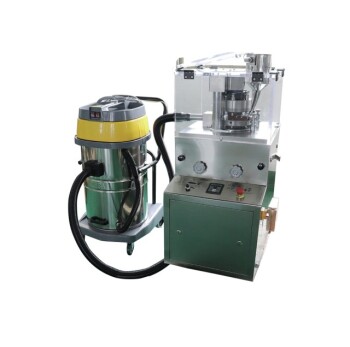
Lab Scale Rotary Single Punch Tablet Press Machine TDP Tablet Punching Machine
This machine is a single-pressure automatic rotating, continuous tableting machine that compresses granular raw materials into various tablets. It is mainly used for tablet production in the pharmaceutical industry, and is also suitable for chemical, food, electronics and other industrial sectors.

Vacuum Hot Press Furnace Machine for Lamination and Heating
Experience clean and precise lamination with Vacuum Lamination Press. Perfect for wafer bonding, thin-film transformations, and LCP lamination. Order now!
Related Articles

Operating of Automatic Lab xrf Pellet Press
How to use the Automatic Lab xrf Pellet Press, including steel ring, plastic ring, boric acid mold

How Much Pressure Do You Need in a Heated Lab Press
Lab presses are versatile and essential tools that are used in various laboratory applications.

Tips With ADJUST THE PRESSURE OF THE LAB PRESS
When designing a pressure test, the required pressure is generally determined based on the material being tested. For example, softer materials may require less pressure than harder materials. The amount of pressure required will also depend on the specific test being performed.

Why do we need to use a lab presses for pelletizing?
Choose a suitable lab tablet press according to the needs of the laboratory

How to choose a laboratory hot press
The laboratory hot pressing machine is suitable for laboratory users who are strict about sample pressing temperature, pressure control accuracy and need a wide size mold for pressing samples. The new lab hot press of KINDLE TECH has a double-plate structure and a pressing force of 0~40 tons.

The Key Features of Lab Presses
Laboratory presses are an essential tool for many scientific applications, including materials science, chemistry, and physics. They are used to create uniform and well-compacted samples for testing, and they can be used for a wide range of materials, including powders, pellets, and films.

An In-Depth Guide on Laboratory Presses and KBr Pellets Production
In the world of scientific research and analysis, laboratory presses and KBr pellet production play a crucial role. These tools are essential in the preparation of samples for various analytical techniques, such as infrared spectroscopy and XRF spectroscopy.

Understanding Laboratory Press and its Functionality in Rubber Industry
In the rubber industry, laboratory presses play a crucial role in the manufacturing process. These presses are used for various purposes, such as rubber vulcanization and testing. Understanding how laboratory presses function is essential for ensuring efficient production and maintaining product quality. In this blog post, we will explore the functionality of laboratory presses in the rubber industry, including their role in the vulcanization process.

Automatic flat plate heat press operating steps

Fully automatic tablet press operating steps and replacement accessories
Relevant introduction to the operating steps and replacement accessories of the fully automatic tablet press

Understanding the Importance and Applications of Laboratory Presses
Laboratory presses play a vital role in various industries, providing precision and consistency in demanding operations. These versatile machines are used for testing, compacting, and molding materials in sectors such as pharmaceutical, laminating, rubber, and plastic molding. Whether it's for R&D, limited production, or lean manufacturing, laboratory presses offer durability and rigorous demand fulfillment.

Unveiling the World of Heated Lab Presses: A Comprehensive Guide
Discover the versatility of heated lab presses in various applications, from sample preparation to material testing. Explore key factors to consider when purchasing a lab press, including pressure, temperature, platen size, and control options.